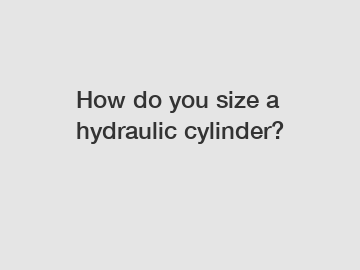Dec. 28, 2023
Machinery
How do you size a hydraulic cylinder?
Hydraulic cylinders are essential components of various machinery, used to convert fluid power into mechanical force and motion. Sizing a hydraulic cylinder correctly is crucial to ensure optimal performance and efficiency. In this article, we will delve into the process of sizing hydraulic cylinders, discussing key factors to consider and steps to follow.
1. Determine the Load:

The first step in sizing a hydraulic cylinder is to understand the load it will be subjected to. Consider the maximum force the cylinder needs to exert and the direction of the force (push or pull). Analyze the load characteristics, such as weight, speed, acceleration, and duty cycles, to accurately calculate the required cylinder size.
2. Calculate the Push Force:
To determine the push force, consider the load weight, gravity, and any additional forces acting on the system. Calculate the total force required using the formula: Force (F) = Mass (m) x Acceleration due to gravity (g) + Additional Forces. For example, if the load weighs 500 kg and there is an additional force of 200 N, the push force can be calculated as: F = (500 kg x 9.81 m/s²) + 200 N = 4,905 N + 200 N = 5,105 N.
3. Define the Required Stroke:
The stroke is the total distance the cylinder piston can travel. To determine the required stroke length, consider the application's specific needs. Ensure that the stroke length is sufficient to accommodate the required motion while leaving some margin for safety and system dynamics.
4. Account for Safety Factors:
It's important to consider safety factors when sizing a hydraulic cylinder. Over-engineering can result in unnecessary costs, while under-sizing can lead to premature failure or inadequate performance. Factors such as application requirements, system dynamics, and the desired service life should be taken into consideration.
5. Calculate the Cylinder Bore Diameter:
The bore diameter is a critical parameter for sizing hydraulic cylinders. It directly affects the cylinder's push and pull force capabilities. The cylinder's bore diameter can be calculated using the formula: Bore Diameter (D) = square root of (4 x Force (F) / (π x Pressure (P))). Pressure, measured in Pascals (Pa), is the hydraulic system pressure. For example, if the calculated force is 5,105 N and the system operates at 10,000 Pa, the bore diameter can be calculated as follows: D = √(4 x 5105 N / (π x 10000 Pa)) ≈ 4.06 cm.
6. Consider Available Cylinder Options:
Once the bore diameter and stroke length are determined, you can select the appropriate cylinder based on available options. Consider factors such as mounting options, cylinder type (single-acting or double-acting), rod diameter, and seals. Ensure compatibility with the overall hydraulic system and any specific requirements of the application.
7. Optimize Hydraulic System Design:
Sizing a hydraulic cylinder is not a standalone task; it should be part of an optimized hydraulic system design. Consider other components such as the hydraulic pump, valves, and hoses. Properly matching these components will result in an efficient and reliable system.
In conclusion, sizing a hydraulic cylinder requires careful consideration of various factors, including the load, stroke length, safety factors, bore diameter, and system design. By accurately determining the forces involved and selecting the right cylinder options, you can ensure optimal performance and longevity of your hydraulic system. Remember to consult manufacturers' catalogs and seek expert advice whenever necessary. So, the next time you ask yourself, "How do you size a hydraulic cylinder?" - you'll have the knowledge to tackle the task efficiently.
For more multi stage telescopic hydraulic cylinder solution, china multi stage telescopic hydraulic cylinder solution, customized ss hydraulic cylinders supplierinformation, please contact us. We will provide professional answers.
Previous: Boost Efficiency & Profitability with Custom Packaging Machines: A Comprehensive Guide
Next: Master the Art of Straightening Wire with Stainless Steel
If you are interested in sending in a Guest Blogger Submission,welcome to write for us!
All Comments ( 0 )